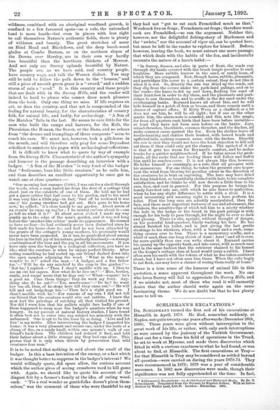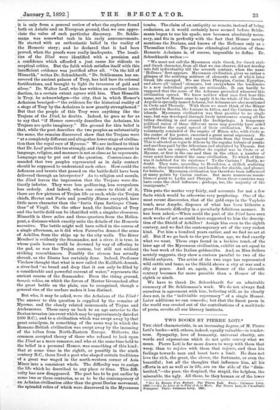SCHLIEM.A.NN'S EXCAVATIONS.*
Da. SCHLIEMANN turned the first sod of his excavations at Hissarlik in April, 1870. He died, somewhat suddenly, at Naples, not quite twenty-one years afterwards (December 26th, 1890). Those years were given without interruption to the great work of his life, or rather, with only such interruptions as were caused by the jealousy of the Turkish Government. Shut out for a time from his field of operations in the Troad, he set to work at Mycente, and made there discoveries which fitted in with a curious exactness to what he had found, or was about to find, at Hissarlik. The first excavations at Troy— for that Hissarlik is Troy may be considered as settled beyond all question—were carried on during the years 1870-73. They were recommenced in 1878; 1879 was a year of considerable successes. In 1882 new discoveries were made, though their significance was not fully apprehended at the time. In fact,
• Schlisniann's Excavations: an dirchzological and Historical Study. By Dr. 0. Schochhardt. Translated from the German by Eugdnie Sellers. With an Intro. action by Walter Leaf, Litt.D. London ; Macmillan. 1891.
it is only from a general review of what the explorer found . both on Asiatic and on European ground, that we can ,appre- ' date the value of each particular discovery. Dr. Schlie- mann was somewhat rash in his early announcements. He started with an enthusiastic belief in the reality of the Homeric story; and he declared that it had been _ proved, when the proofs were really inadequate. The locali- ties of the Iliad were identified with a precision and a confidence which afforded a just cause for ridicule to sceptical critics. But the faith which satisfies itself with this insufficient evidence was justified after all. " On the hill of Hissarlik," writes Dr. Schuchhardt, " Dr. Schlieraann has un- covered the ancient palaces of Troy, has laid bare its colossal fortifications, and brought to light its treasures of gold and silver." Dr. Walter Leaf, who has written an excellent intro- . 'auction, to a certain extent agrees with him. That Hissarlik _ is Troy, be acknowledges—the city, that is, which Homer's Achaians beseiged—" the evidence for the historical reality of a siege of Troy by the Achaians is now greatly strengthened." But that the people of this Troy were anything like the Trojans of the Mad, he doubts. Indeed, he goes so far as to say that "if Homer correctly describes the Achaians, his Trojans are quite imaginary." His ground for this belief is that, while the poet describes the two peoples as substantially the same, the remains discovered show that the Trojans were "at a completely different and altogether lower stage of civilisa- tion than the royal race of Myeena3." We are inclined to think that Dr. Leaf puts this too strongly, and that the agreement in language, religion, and manners is not so close as he represents. Language may be put out of the question. Convenience de- manded that two peoples represented as in daily contact should be supposed to understand each other. How could the defiances and taunts that passed on the battle-field have been delivered through an interpreter P As to religion and morals, the Iliad leaves the impression that the Trojans were dis- tinctly inferior. They were less godfearing, less scrupulous, less orderly. And indeed, when one comes to think of it, there are few pictures of Trojan life as such, while the Trojan chiefs, Hector and Paris and possibly 2Eneas excepted, have little more character than the "fortis Gyas fortisque Cloan- thus " of Virgil. On the other hand, the localities of Troy and the battle-field can be identified with a singular closeness. Hissarlik is three miles and three-quarters from the Helles- pont, a distance which exactly suits the details of the Homeric narrative. The battle might well have rolled in the course of a single afternoon, as it did when Patroclus donned the arms of Achilles, from the ships up to the city walls. The River Menders is evidently the Scamander, not a river, it is true, in whose pools horses could be drowned by way of offering to the god, as was the Trojan custom, but still not without striking resemblances. Possibly the stream has actually shrunk, as the Ilissus has certainly done. Indeed, Professor
• Virchow thought that what is now called the Kalifatli-Asmak, a river-bed " so broad and deep that it can only be filled by a considerable and powerful current of water," represents the ancient course of the Scamander. Even the rising ground, Opeactpic grAioro, on which the forces of Hector bivouacked after the great battle on the plain, can be recognised, though a general rise of the surface makes it less distinct.
But who, it may be asked, were the Achaians of the Iliad ? The answer to this question is supplied by the remains of Mycenm, and the closely related monuments of Tiryns and Archemenus. These carry us back to an age anterior to the Dorian invasion (an event which may be approximately dated at 1000 B.C.), and to a civilisation which was swept away by that great cataclysm, in something of the same way in which the Romano-British civilisation was swept away by the incoming of the tribes from North-Eastern Europe. Hitherto, the common accepted theory of those who refused to look upon the Iliad as a mere romance, and who at the same time held to the belief in a personal Homer, was something of this kind: that at some time in the eighth, or possibly in the ninth century B.C., there lived a poet who shaped certain traditions of a great war waged in the north-western corner of Asia Minor into a consistent whole. The difficulty was to assign the life which he described to any place or time. This diffi- culty has now disappeared. The poet has to be put earlier by some two or three centuries, so as to be the contemporary of an Achaian civilisation older than the great Dorian movement, the splendid relics of which were discovered in the Mycenaean
tombs. The claim of an antiquity so remote, instead of being audacious, as it would certainly have seemed before Schlie- mann began to use his spade, now becomes absolutely neces- sary, and fits in perfectly with the fact that Homer merely mentions the Dorians, and knows of the Hellenes only as a Thessalian tribe. The precise ethnological relation of these Homeric Achaians is, of course, impossible to define. Dr. Schucbhardt writes :— "We must not call the Mycenaean style Greek, for Greek style and Greek character, from all that we can observe, did not develop into full individuality till the seventh century, when the name Hellenes' first appears. Mycenaean civilisation gives us rather a glimpse of the seething mixture of elements out of which later Greek life emerged. We see there Phrygian, Carian, Egyptian, and above all ' island ' elements, but everywhere the tendencies to a new individual growth are noticeable. It can hardly be supposed that the name of the Achreans prevailed wherever this civilisation spread. We know neither what race first bore this name, nor how Homer came to apply it to the whole of the Greeks. Argolis is specially named Achwan, but Achteans are also mentioned in Crete and Thessaly. With them we must think of the Minys as settled in Bceotia, the Ionians in Attica, and the Carians on the islands. Mycenaean civilisation was thus peculiar to no single race, but was developed through lively intercourse among all the tribes dwelling in and around the Archipelago. A temporary political union of these different races may possibly have aided still further the equal spread of their civilisation. We are in- voluntarily reminded of the empire of Minos, who, with Crete as the centre of his power, exercised a great naval supremacy. He subdued the Carians, and exacted tribute from the Greek coast. This is attested as regards Athens by the regular tribute of youths and maidens paid by the Athenians and abolished by Theseus. But within such an empire, whether its capital was in Crete or at lIttycente, or first in the one and then in the other, a number of races must have shared the same civilisation. To which of these was it indebted for its existence ? To the Carians P Partly, no doubt. They were, according to Herodotos, a skilled, seafaring nation; they invented devices and handles for shields, and plumes for helmets. Mycenaean civilisation has therefore been influenced at many points by Carian custom. But more numerous resem- blances point to Lydia and Phrygia. From these countries may have come the chief influence ; perhaps, too, the majority of the immigrants."
This puts the matter very fairly, and accounts for not a few facts which would be otherwise very perplexing. One of the most recent discoveries, that of the gold cups in the Vapheio tomb, near Amydte, disposes of what has been hitherto a great Homeric difficulty in a peculiarly felicitous manner. It has been asked,—When could the poet of the Iliad have seen such works of art as could have suggested to him the descrip- tion of the Shield of Achilles P Assign him even to the eighth century, and we find the contemporary art of the very rudest kind. Put him a hundred years earlier, and we find no art at. all. But if we go back to the pre-Dorian age, we find exactly what we want. These cups found in a beehive tomb, of the later age of the Mycenaean civilisation, exhibit an art equal to the best work of the Italian goldsmiths. And, as Miss Sellers acutely suggests, they show a curious parallel to two of the Shield subjects. The artist of the two cups has represented wild cattle and tame, as the Shield shows a city at war and a city at peace. And so, again, a Homer of the eleventh century becomes far more possible than a Homer of the eighth or ninth.
We have to thank Dr. Soh uchhardt for an admirable summary of Dr. Schliemann's work. We do not always End ourselves in agreement with him, believing still, as he clearly does not, in the "indivisible supremacy" of a single Homer. Later additions we can concede; but that the finest poem in the world was created out of the contributions of a multitude of poets, revolts all our literary instincts.















































 Previous page
Previous page